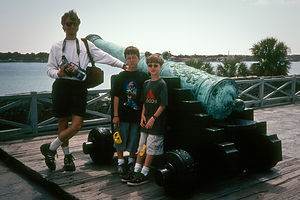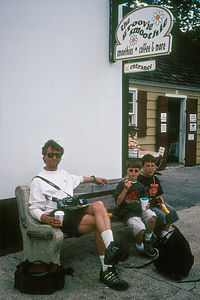- Home
- About
- Map
- Trips
- Bringing Boat West
- Migration West
- Solo Motorcycle Ride
- Final Family XC Trip
- Colorado Rockies
- Graduates' XC Trip
- Yosemite & Nevada
- Colorado & Utah
- Best of Utah
- Southern Loop
- Pacific Northwest
- Northern Loop
- Los Angeles to NYC
- East Coast Trips
- Martha's Vineyard
- 1 Week in Quebec
- Southeast Coast
- NH Backpacking
- Martha's Vineyard
- Canadian Maritimes
- Ocracoke Island
- Edisto Island
- First Landing '02
- Hunting Island '02
- Stowe in Winter
- Hunting Island '01
- Lake Placid
- Chesapeake
- Provincetown
- Hunting Island '00
- Acadia in Winter
- Boston Suburbs
- Niagara Falls
- First Landing '99
- Cape Hatteras
- West Coast Trips
- Burning Man
- Utah Off-Roading
- Maui
- Mojave 4WD Course
- Colorado River Rafting
- Bishop & Death Valley
- Kauai
- Yosemite Fall
- Utah Off-Road
- Lost Coast
- Yosemite Valley
- Arizona and New Mexico
- Pescadero & Capitola
- Bishop & Death Valley
- San Diego, Anza Borrego, Joshua Tree
- Carmel
- Death Valley in Fall
- Yosemite in the Fall
- Pacific Northwest
- Utah Off-Roading
- Southern CA Deserts
- Yosemite & Covid
- Lake Powell Covid
- Eastern Sierra & Covid
- Bishop & Death Valley
- Central & SE Oregon
- Mojave Road
- Eastern Sierra
- Trinity Alps
- Tuolumne Meadows
- Lake Powell Boating
- Eastern Sierra
- Yosemite Winter
- Hawaii
- 4WD Eastern Sierra
- 4WD Death Valley +
- Southern CA Deserts
- Christmas in Tahoe
- Yosemite & Pinnacles
- Totality
- Yosemite & Sierra
- Yosemite Christmas
- Yosemite, San Diego
- Yosemite & North CA
- Seattle to Sierra
- Southwest Deserts
- Yosemite & Sierra
- Pacific Northwest
- Yosemite & South CA
- Pacific Northwest
- Northern California
- Southern Alaska
- Vancouver Island
- International Trips
- Index
- Tips
- Books
- Photos/Videos
- Search
- Contact
St. Augustine, FL
Wednesday, April 26, 2000 - 3:30am by Lolo
116 miles and 2.25 hours from our last stop
Travelogue
I must confess that part of our motivation for visiting St. Augustine before heading back to Hunting Island was to add Florida to our state map. It was just too close to Jekyll Island to pass up. Whatever the reason, I'm still glad we got a chance to see this old historical city.
 Herb and boys at CastilloI've always thought of Jamestown and Plymouth as the earliest settlements, but St. Augustine was actually settled by the Spanish almost a half a century earlier. Thanks to the foresight of a 19th-century oil tycoon named Henry Flagler, many Spanish Colonial era buildings have been preserved and restored.
Herb and boys at CastilloI've always thought of Jamestown and Plymouth as the earliest settlements, but St. Augustine was actually settled by the Spanish almost a half a century earlier. Thanks to the foresight of a 19th-century oil tycoon named Henry Flagler, many Spanish Colonial era buildings have been preserved and restored.
We began our exploration of the Old Town at the Old City Gate. After passing through the gate, we strolled along St. George Street, a narrow pedestrian lane, lined with restaurants, shops, ice cream parlors, historic sites, and lots of people. This is the heart of the historic district and there was definitely an old world feel to it. The kids enjoyed a large, sloppy "new world" ice cream.
Our next stop was the fortress Castillo de San Marcos, which has now been preserved as a National Monument. This fort helped the Spanish fend off the many British attacks on the city during the 18th century. It was also occupied by Union troops during the Civil War. I think the kids were a bit bored and anxious to get back to Hunting Island to swim.
After the fort, we had a family argument as to what to do next. Tommy very much wanted to go to the Ripley's Believe It Or Not! musuem. I, however, said we had just been to one in Las Vegas the previous summer and had no desire to see the World's Largest Hairball. Besides, I wanted to see something more unique to St. Augustine, such as the Fountain of Youth. I probably had an ulterior motive for visiting there as well. Since I'm bigger and in charge of the itinerary, we went to the Fountain of Youth National Archaelogical Park. Tommy was not a happy camper. I must admit that the park was a bit touristy and a little hokey. Also, the water tasted like sulfur and I didn't look any younger when I was done with it.
Then it was back to RV and north to our campsite on Hunting Island."
Description
St. Augustine, on the northern coast of Florida, is the oldest European city in the United States. The area was first visited by Ponce de Leon in 1513, but it was Jaun Menendez de Aviles and 100 settlers who established the first settlement in 1565, 42 years before the first English settlers landed in Jamestown. St. Augustine became the Spanish's center of power in North America for the next 200 years. During that time period, control of Florida passed back and forth between Britain and Spain until 1821, when Spain peaceably turned over its colonies in Florida (including St. Augustine) to the United States.
 Herb and boys enjoying ice creamIn 1883, Henry Flagler, the oil tycoon, visited the city and was so impressed by its old Spanish Colonial buildings that he invested in restorating the city and developing it into a winter resort. Today, thanks to him, the heart of St. Augustine retains the flavor of a 16th century Spanish Colonial walled town.
Herb and boys enjoying ice creamIn 1883, Henry Flagler, the oil tycoon, visited the city and was so impressed by its old Spanish Colonial buildings that he invested in restorating the city and developing it into a winter resort. Today, thanks to him, the heart of St. Augustine retains the flavor of a 16th century Spanish Colonial walled town.
A good place to begin an exploration of the Old Town is along St. George Street, a narrow pedestrian thoroughfare that runs six blocks from the Old City Gate on the north end to the Plaza de la Constitucion on the southern end. It is here where you will find many of the Spanish Colonial era buildings, such as 1713 Government House, the 1825 Trinitiy Episcopal Church, and the 1797 Basilica Cathedral of St. Augustine, one of the oldest Catholic churches in the U.S. A fun stop is Oldest Store Musuem, which is a representation of a 19th century general store.
The area south of the Plaza is the oldest part of St. Augustine. Three blocks south of the Plaza at 14 St. Francis Street is the Oldest House, a Spanish Colonial residence built around 1706. It is the oldest surviving residence in the city's history.
Another must-see is the Castillo de San Marcos, a military fortress built by the Spanish in 1672 to protect themselves from the ever expanding British Empire. This fortress, which is now a National Monument, has a rich history. It successfully repelled the British attacks of the 18th century, was occupied by Union troops during the American Civil War, and later served as a prison for the Native American leader Osceola.
St. Augustine is also home to the Fountain of Youth National Archaeological Park, created as a tribute to the city's claim to be the spot where Ponce de Leon is said to have landed. The Fountain of Youth is the legendary spring that reputedly restores the youth of anyone who drinks its waters. Though the fountain situated there is not "the" Fountain, this does not stop tourists from drinking its water. The park exhibits native and colonial artifacts to celebrate St. Augustine's Native American and Spanish heritage.
- ‹ previous
- 6 of 11
- next ›
St. Augustine location map
Javascript is required to view this map.
